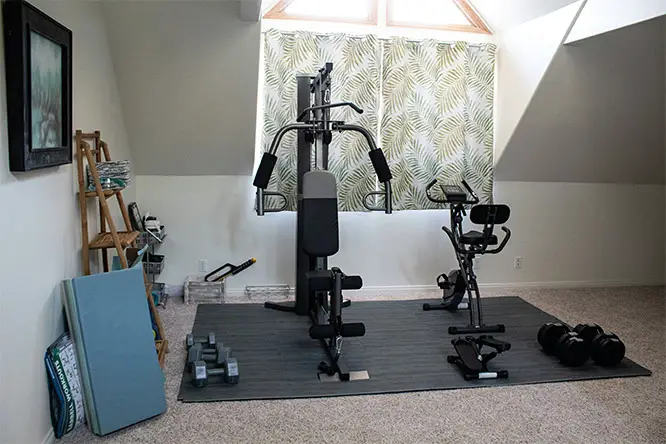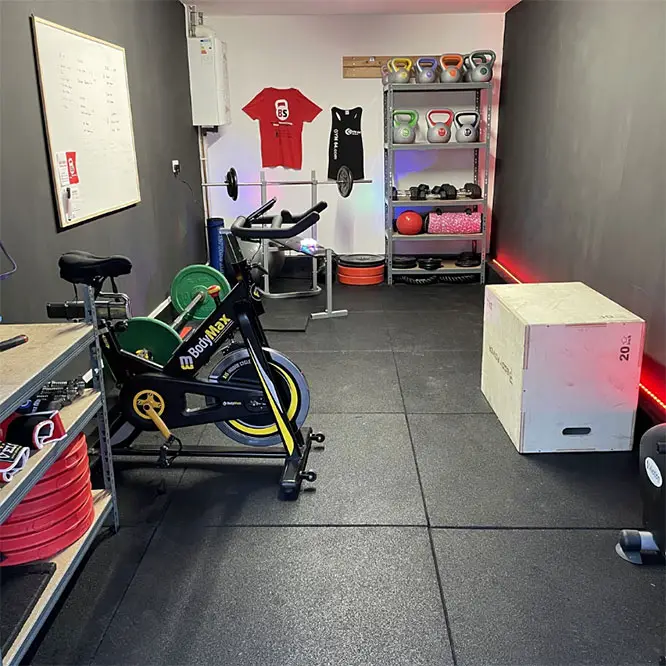Table of Contents
Exercising at home is not a new thing. We all remember the 80’s and 90’s versions of workout videos and most of us have tried the ‘tins of beans’ method of strength training at least once.
While some of us are happy to roll out a mat in the Living Room floor or squat in a corner of the bedroom with a pair of dumbbells, getting your daily fix of exercise at home amidst family life can be a challenge, both in terms of space and consistency. Others, on the other hand, have opted for the home gym route and carved out a dedicated workout space for regular exercise on their clock.
In this article we look at how effective these differing approaches are to home fitness.
Can you keep up with daily exercise without the necessary space to embrace personal goals?
Maybe a home gym seems like an indulgence when you can achieve the same results from more compact workouts?
Whatever way you choose to exercise at home, let’s find out if a home gym really is the answer to consistent and effective exercise, and more to the point, can it be sustained for long-term success.

How & Why Has Home Exercise Changed?
Attitudes to at-home fitness have changed dramatically over recent years. Prior to the pandemic, home workouts were hugely popular but an exercise session tended to be snatched during an evening or weekend. Often carried out in front of a laptop or spare corner of the house, home workouts were less about a concrete lifestyle choice and more about squeezing some exercises in on random days.
Home gyms were also less common unless you were a working personal trainer facilitating clients from a home studio. Often under-used and seen as more of a luxury, home style gyms didn’t really become a ‘thing’ until the offset of the pandemic.
Impact of Covid19
During lockdown amid the Covid19 crisis, many of us had the time to reexamine our relationship with exercise and where it fits into our lives. For a lot of people it reawakened the grave reality that without good health and wellness, everything else loses its value. Many of us were forced to confront health and weight issues and most of us wanted to improve our ‘daily struggles’ with exercise in general.
Alongside this newer outlook and the closure of commercial gym facilities, the UK market saw a massive upsurge in home fitness products as people took workouts in-house.
Post Pandemic
Since 2020 research from Globadata UK shows that approx 53% of consumers in the UK have purchased home gym products, with 52% claiming they have done regular workouts since the pandemic. A whopping 76% of this group say they will continue with home fitness post pandemic. This reveals a significant shift in how people approach fitness with the majority preferring to practice workouts from home.
Similarly, a study from Garage Gym Reviews (February 2023) reveals a long-term switch on how people are investing in home fitness, with 61% having a designated exercise zone at home or workout studio. More and more of us are taking matters into our own hands when it comes to personal fitness goals and investing the time, money and effort into long-term wellness.
Increase of Smart Equipment, Wearables & Interactive Content
With the amount of at-home workout options on the rise there has never been such a wide variety of DIY fitness content at our fingertips. From online classes, and SMART gym equipment to social media tips and wearables, the scale of options available for interactive training and solo workouts is immense.
People are constantly looking for flexible and fresh workout material that is entirely suited to their needs which they can’t access so readily through a gym membership.
The cost of living crisis has also impacted on how avid exercisers choose to get their dose of fitness. Home fitness is less expensive than gym memberships and tends to be more budget-friendly in a climate where general prices are rising every few months.
So, How Do Home Exercisers Keep Motivated?
Completing workouts on a regular basis is not just about strength and physical endurance. There is a lot to be said about mental toughness – a term usually referred to athletes and top performers in sport.
A particular study discussed by Danielle Burns explores the idea of how casual exercisers can adopt the same mental stamina as fitness pros by having long-term goals in mind and focusing on motivation as a skill to get them there.
So what actually DOES motivate us to exercise regularly?
According to academic research (Pedro J Teixeira et al) self-regulation, long-term goal making, enjoyment/excitement and fulfillment of needs are just some of the basic motivators in individuals who routinely exercise.
With that being said, let’s look into how these can be broken down in terms of home exercising.
Fluid Workouts
Having the ability to perform a workout with rhythm and proper intention makes for a more fluid workout process. If you are constantly having to switch positions, search for equipment or change device settings it can interrupt your flow. This in turn can hinder your overall commitment to finishing a workout or showing up for the next one.
A home gym set-up enables home exercisers to optimise how they workout. Having adequate space and easily accessible kit means more productivity and satisfaction – a real motivation booster.

Versatile & Accessible Equipment
Noone wants to search for dumbbells under the bed when they are pumped up and ready to workout. This is when storage and space comes into play. A home gym can be fitted-out with clever storage solutions that save space and allow for easy and quick access.
Equipment that is not always in use can safely be stacked away or neatly arranged for fast selection.
Workout Variety
Workout variety is about keeping your routine fresh and challenging. Sticking to the same exercise plan or repeatedly using the same equipment can quickly become stagnant. This is one of the most common reasons for drifting away from regular workouts and falling off the wagon. In other words, you become bored and discouraged.
A home gym allows you the freedom to be more creative with your routine. You’re able to store different types of equipment such as a power rack for barbell lifting, bikes and rowers for cardio and create floor space for HIIT sessions or even Yoga and Pilates. Having the option to switch up a dull routine and introduce new equipment gives you a much better chance of maintaining your fitness goals.
Group & Solo Exercise Options
We’re all aware of how group exercise can buoy up motivation, keep us accountable and help us to remain committed to regular workouts. Working out alone also has its benefits from a deeper focus on personal targets, mastering form and enhancing performance to tailoring your routine to exactly how you want it.
Having a home gym allows you to explore the best of both worlds. You can arrange group workouts with friends, colleagues and family if you enjoy the community aspect of group fitness. Alternatively, you can connect with others through online classes or interactive apps without physically leaving home.
Personal Space & Time
Many home gymers value the ‘me time’ when working out at home. Having your own, dedicated space for exercise can impel you to take more time for yourself and invest in personal fitness at your own pace.
Choice
Choice is so important in exercise. Having ownership over fitness goals and workout routines can empower individuals to take charge of their journey and take responsibility for their own progression and success.
Is a Casual Approach to Fitness Better?
While it is clear to see why a home gym helps many exercisers stay ahead of their goals, for others, a gym environment doesn’t always cut it.
Exercising in the Living Room for short periods helped Abbi Henderson (Marie-Claire Fitness Journalist) when she hit a slump with gym motivation last Autumn.
Previously an avid gym-goer, Abbi swapped long hours at the gym working to maximum capacity for shorter workout sessions in the comfort of her Living Room. She found getting to the gym in the winter months harder than usual which meant missing sessions and being inactive all day.
“When I workout at home, however, I allow myself full-time flexibility – I can lift first thing in the morning or at 9 pm at night if I want. I can get some movement in on my lunch break since I won’t lose any time commuting to and from the gym, and sometimes I’ll even opt for short but sweet exercise snacks throughout the day; doing a set here and there, in-between work, until I’ve finished the workout”
Abbi believes that a less strict workout structure and the informal setting of home helped reclaim her motivation and enjoyment of workouts that seemed to have taken a dive.
Similarly, placing too many demands on yourself and setting steep goals can have a more detrimental effect on motivation and set ourselves up for failure.
The Pros & Cons of a Home Gym
Not everyone will benefit from a home gym. After all, exercise is a personal thing and everybody enjoys different forms of fitness and how they go about it. Let’s focus on the benefits and drawbacks of a home gym.
Pros
Flexibility
You can live by your own workout schedule and choose when you train. This is particularly handy for people with young children or those who have different working patterns than most.
Cost
The price of gym memberships and travel soon add up. A home gym means you save on the regular cost of gym visits.
Consistency
Having a gym at home allows you to be more consistent with your workouts. You can plan sessions, track your progress more effectively and it is much easier to set yourself a regular pattern to stick with and which works with your schedule.
Elevated Experience
Getting parked and queuing for equipment machines are just some of the things you won’t miss with a home gym. You can take your time, have full access to kit and be able to enjoy your exercise time without feeling forced to speak and engage with people if you don’t feel like it.
Family Friendly
Having a gym at home is a great way to encourage other members of the family to take part in regular exercise as well as setting a positive example for children in adopting a fitness-focused lifestyle.
Cons
Initial Expense
Setting up a gym from scratch can have quite a big financial outlay. For it to work long-term, you need to invest in a proper set-up that can quickly become expensive. If you set a budget and stick to what you can afford, a home gym can be as basic as you need without going overboard with costly equipment that you may not use.
Space
To achieve a successful home gym, there needs to be enough space to move around in and to store equipment. Not everyone has extra space to dedicate to a gym.
Noise
Workouts can be noisy. The sound of dropping weights or loud music can penetrate through walls and disrupt other members of the family, or even neighbours depending on where you live. Even though there are excellent sound-reducing gym floor systems available, home gyms might just not work for certain households.
Quick Tips on How to Create a Home Gym
There are a few important things to think about before adding a gym to your home layout. Space, accessibility and cost are just some of the factors to take into account. Here are a few simple tips to get you started.
Choose your location wisely
Choose a room or area with enough space to freely move around in and can accommodate the gym equipment you want to use regularly. A home gym doesn’t need to be big but you should have enough room to safely carry out functional exercise, use weights (if that’s your plan) and that there’s adequate space to store kit. Opt for space-saving wall mounted racks and foldable equipment to maximise floor space. The important thing is to consider your layout before investing in equipment so you know what dimensions you have to play with.
Set a Budget
A large part of a room conversion is budget. Decide how much you want to invest in the space beforehand so you can make informed choices when it comes to wall and floor preparation, flooring, lighting and gym equipment. Depending on the scale of your project, the chosen location and intended use (ie what type of exercise you plan to do and how often) it is worth weighing up the advantages of spending a bit more money on a proper set-up if you plan to invest in your fitness long-term.
On the otherhand, there are tons of cost-saving options out there from secondhand equipment to DIY hacks that can transform a room into a fully, functional gym space without putting a dent in your expenses.
Opt for proper Gym Flooring & Safety Mats
One of the key components of a safe and durable gym space is the flooring. Select high quality rubber gym flooring which is shock absorbent, low maintenance and easy to install. Not only will professional gym flooring protect your subfloor from damage and injury but it will reduce noise and insulate against draughts and temperature change. This will save you money in the long-term by preventing damage or replacing sub-standard flooring due to premature wear.

Personalise Your Space
Try to make your gym feel like a sanctuary – a place you can escape to and exercise, meditate or have some time to yourself. Make it about you. Add your own personal stamp on it with a décor style that says something about your character. Consider lighting, shelving, music and media set-up, tracking and planning charts and even inspirational wall art.
If you treat the space as somewhere that you associate with self-care and investing in yourself, you are much more likely to enjoy your workouts and spend more time there.
Final Thoughts
Being active, in any form is a great thing and there are no set rules on how you achieve it. There are, however, ways of making exercise work for you in the best way possible. That is especially true for those who want to invest in lifestyle fitness – a way of living that places wellness and strength at the core of day-to-day life.
Not everyone has the space for a home or garage gym and casual workouts in the front lounge tick all the boxes for those of us who prefer a flexible and more relaxed approach to working out. In fact, it is the prime motivator for active people who become derailed with the highly charged environment of a commercial gym or the commitment involved in setting up a home gym.
In terms of long-term success however, a home studio can be a game changer in supporting consistency, accountability and personal ownership of fitness goals. A home gym simplifies the cycle of regular fitness making it much more accessible and obtainable. When home gymers get a taste of consistent workouts and the evidence that it is working for them, this in turn serves as motivation to continue their journey.
If you can determine where you stand in this, whether you’re a Living Room Lunger or a Home Gym Hero, nothing should stand in your way of long-term success and reaching those milestones.
Author
Katie McKay is a blogger for brand Sprung and the company website Gym-Flooring.com




More Stories
Ashwagandha’s Impact on Cortisol Levels in Stressed People
Health care cyberattack ‘likely one of the worst,’ expert says
Accessing Medicinal Cannabis in the UK: A Comprehensive Guide